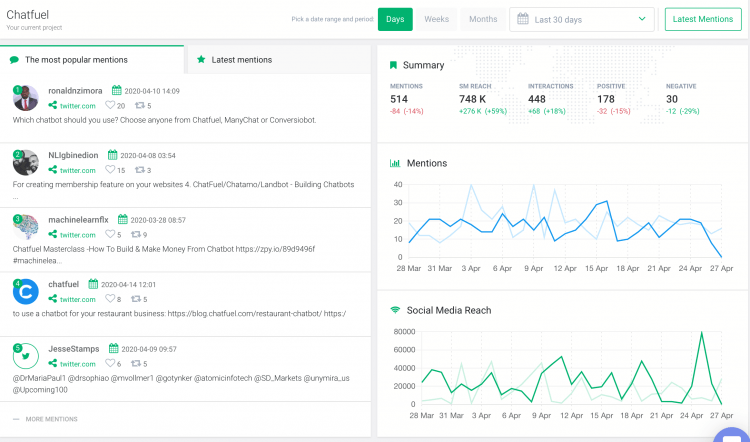Internet monitoring and competitive benchmarking
Table of contents
Competitive benchmarking is the process of comparing your company against your competitors to identify best practices in your industry. The process can benefit your company in multiple ways – it can help generate new ideas to improve operations and sales, identify new technologies that could reduce costs, or strengthen customer loyalty and satisfaction. A result of benchmarking process is eliminating gaps in service or acquisition of competitive advantage.
There are clear benefits of competitive benchmarking.
Competitive benchmarking will give you vital information about your business. The process will highlight your strengths and weaknesses, and will help you spot opportunities within your business niche. Competitive benchmarking is the first step towards competitor analysis.
To conduct a benchmarking analysis, you’ll need to have a clear overview of your company’s performance on many different levels.
Once you gather the data, you can easily spot the areas you can improve to stay one step ahead of your competitors. You will pinpoint the space your competitors have problems with and be able to put your business ahead.
There are multiple ways you can implement competitive benchmarking. The most popular are:
- Process benchmarking — where you identify the most vital processes and break it down to incorporate the best practices into your own business;
- Performance benchmarking — where you look for the outcomes of various marketing activities;
- Strategic benchmarking — this type of benchmarking is used to compare different approaches to core business activities.
Here’s everything you need to know about competitive benchmarking.
What is competitive benchmarking?
Competitive benchmarking is a process of comparing your company to your competitors by analysing a set of predefined metrics.
Competitive benchmarking will help you assess the performance of your brand and better understand the results by putting the numbers in the right context.
The process of competitive benchmarking goes a bit further than just comparing the numbers. If you want to gain actionable insights, you should also pay attention to the best practices that make the results possible.
A thorough analysis of the competitive benchmarks will give you information necessary for further development of your company.
How to do a competitive benchmarking analysis?
There are several steps that you have to go through.
The first one should be choosing the right benchmarks. One of the most obvious choices is a pre-existing key performance indicator. That is a good starting point as you’ve probably been monitoring it for some time, and you got some reliable data.
But ask yourself this – what exactly do you want to benchmark?
If you have a specific goal in mind think about the metrics that accompany that target. If you’re going to benchmark against your competitors in customer service or customer retention, you have to gather performance metrics, such as churn rate or first response time.
You should think about metrics that are early signals for more significant problems or opportunities. Has the number of subscribers to your email newsletter dropped recently? Your competitors might be implementing a new strategy that is much more attractive to your target customers. Or you’ve fallen behind the latest marketing trends. To stay up to date, you have to investigate.
Once you pick the benchmarks you are going to follow, take a deeper look at your competitors. Find business that will help you bring your business to another level. Identify the strengths of your competitors and find out what is the secret to their success.
The final step of competitive benchmarking is analysing the data and drawing actionable conclusions. The goal is not to emulate your competitors strategy, rather finding out what to do to improve your results.
How to choose competitive benchmarks?
The first step of competitive benchmarking should choosing the right benchmarks to measure.
The path of least resistance is to measure the metrics you already track regularly. You probably have a good set of historical data and the right set of tools you are familiar with.
But conducting a competitive analysis gives you an opportunity to take a look at various metrics you neglected so far. You should choose the metrics that will give you the insights that will help you become the industry leader.
Take a look at the share of voice. Sudden drops in this metric could indicate that you should adjust your marketing tactics. By analysing your competitors share of voice, you can identify the industry leaders and analyse their activities.
Of course, the answer to your problems is not to copy your competitors every move. But the more you know, the better decisions you will make.
How to choose competitors to benchmark?
If your benchmarking study is to be successful, you have to choose the right companies to benchmark against. You can divide the competitors into four groups:
- Similar businesses
That’s pretty straightforward. You have to take a look at companies of similar size and in a similar industry. You can compare products and services, and see whether they come up with some groundbreaking ideas.
- Industry leaders
These are the most prominent companies; businesses you’d love to be when you grow up. They already did a lot of work and got the foundations you can base your operations upon. Knowing how they operate will help you become one of them.
- Smaller companies
The problem of almost all small companies that are just starting off is the lack of investment funds. But it’s also one of their most considerable advantages. They have to be creative because sometimes they simply can’t afford big, expensive, and trusted solutions. Growth-hacking was an answer to the tight marketing budget. They can look at a problem from a completely different perspective and deliver fresh solutions.
Moreover, smaller companies might catch up with you one day, and through thorough benchmarking, you won’t be caught off-guard.
- Leaders in a specific niche
Companies from completely different industries can deliver valuable insights as well. They can be leaders in a clearly defined business process. This approach is called strategic benchmarking; looking beyond the firm’s core industry to companies that are known for their world-class performance in a given field.
Need an example? Here’s one! We’ve been recently looking for a way to pimp out our newsletter. Of course, we analysed what leaders in SaaS industry send out, but then it hit us – why limit ourselves to only one branch? We discovered that unquestionable leader in the newsletter games is The New York Times. So we’re currently in the process of analysing their strategy, and who knows, there might be some parts of it we could implement.

How to track competitive benchmarking data?
We’re now at the hardest part of the problem. How exactly do you access all the information you need for the competitive benchmarking analysis?
It seems like an extremely difficult task. For starters, companies don’t want to reveal information you’ll use in your performance benchmarking. Fortunately, there are plenty of tools that will help you get the information you need.
SEO metrics
Let’s start with SEO metrics. These pieces of information are publicly available and very useful.
Tools like SEMrush will analyse your site against main competitors in your industry and deliver all the data in a legible report. You will get the information about the domain authority, keyword gap, the number of backlinks,
The disadvantage of the data is that you have to pay for most of the tools.
Internet monitoring
The key to successful benchmarking dossier is conducting proper research. There are plenty of information out there, the only problem is to find them.
Here the solution is Internet monitoring tool, for example, Brand24. When you set up a project, the tool will collect all the mentions with given keywords. You won’t miss any update such as press release, sales report or social media mentions.
Brand24 will gather and analyse the mentions. You will get the data about:
- the volume of mentions
- sentiment of the mentions
- social media reach
- the total number and type of interactions
- the share of voice
- top public profiles mentioning the keyword
- influence score
I know that the volume of information can be quite intimidating, but we got you covered. In Brand24 you can apply filters to your project and analyse only the data you need.

Take a look at the Summary of the results for Chatfuel, a SaaS solution for chatbots.
Examining the results at glance, you can clearly see that the social media reach of their posts is growing. Why is that?
The answer is in the Mentions tab. The Mentions tab will not only tell you which social media platform was the most popular.
If you browse through the results, you will see what the users like and dislike about the tool.
That’s an indicator of an area where you can beat your competitor!

Using media monitoring tool for competitive benchmarking will give you the data you need to measure the share of voice, brand awareness, brand sentiment, customer satisfaction, and social media reach.
Start competitive analysis! Brand24 offers a 14-day free trial (no credit card required)
Professional companies
Another way to get hold of data you need is to hire professionals. Companies like Nielsen or Ipsos conduct can provide you with benchmarking data.
Survey
You can try to do it all on your own as well. Simple solutions are usually the best so why not just… ask? The advantages of this process are that you’ll be able precisely the data you need – you ask precise questions to people you want answers from.
The process is, however, time-consuming and costly. And you may not get enough results to draw valuable conclusions.
How to analyse the results of competitive benchmarking?
After the analysis part comes to the implementation. As always, you need a plan. First, define the SMART actions that you have to take. And by SMART I mean:
- Specific – the more specifically you define your goal, the easier it will be to achieve it;
- Measurable – staying on top of things will certainly be easier if you can measure your progress. Set up mid-term goals to measure your progress;
- Attainable – if you’re planning on building your company within a month and retiring after you most likely will fail. That’s why it’s important to set up goals that you’ll be able to achieve;
- Relevant – the goals should be relevant for you – don’t fulfil someone else’s wishes or desires. It’s also vital to make your goals realistic, so if you’re just implementing brand new strategy don’t expect thousands of new customers within the first week;
- Time-Based – a goal is not a goal if it’s not time-bound. The deadline will motivate you to work harder to accomplish it.
Competitive benchmarking is a continuous process, and it’s vital to monitor the effects of implementation as well as further development of competitors’ strategies.
Competitive benchmarking in a nutshell
Competitive benchmarking will give you a broad overview of marketing activities. You will be able to pinpoint the current status of your organization. Competitve benchmarking will deliver the insights necessary to improve your business.
Benchmarking involves a lot of research work. You have to gather and analyse the information meticulously. But in our fast-paced, always-on world, the process of continuous improvement is inevitable to survive.
HANDPICKED RELATED CONTENT
Brand monitoring tips and tools [2020 update]